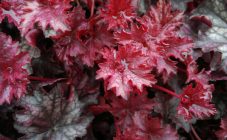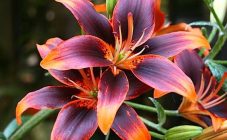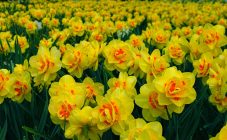Content:
It is difficult to find a person who does not know what snowdrops look like, because this is the first flower of the spring season. This bulbous plant comes from the genus Amaryllis. Snowdrop is a frost-resistant flower that blooms every year even before the snow crust disappears from the ground. Galanthus (as the snowdrop is called in another way) is distinguished by its diminutiveness, tenderness. Today, there are 20 varieties of this plant. It is often used to create unique landscaping designs. Most varieties of snowdrop flowers are white. The best places for their germination will be: deciduous forest, glades, shrubs, botanical garden. A detailed description of the plant contains the Red Book.
About the history of the plant
The existence of the snowdrop has been known to mankind since the first millennium. This, in particular, is evidenced by the tradition to call the snowdrop "milk flower". In the Middle Ages, it began to be associated with purity and purity. The widespread distribution and transplantation of plants around the world began in the 19th century. Officially, the plant received the first "registration address" in England, because it was there that it was entered in the corresponding register of local plants. It happened in 1984.
What is grown for
The landscape is completely transformed when the snowdrops are in bloom. This plant is stretched out with a green rug, which you constantly want to admire. The incredible decorative appearance of the plant is the main reason that makes people grow and care for the flower, protect it and put it in the Red Book.
Since galanthuses are poisonous plants rich in active alkaloids, they are also often used in medicine. Components extracted from the plant are often used to treat conditions such as:
- oncological diseases;
- polyneuritis;
- nerve injury;
- myopathy;
- furuncle;
- fungal diseases;
- intestinal atony.
Plant characteristic
Snowdrop is a perennial plant with a fairly short growing season (it depends on the plant's height above sea level). The seed is the bulb. It is small in diameter (only 2-3 cm) and consists of scales that are added every year. Separate oblong leaves extend from each bulb.
They appear almost simultaneously with the buds, however, during the flowering period, they are much shorter than the peduncle. After the completion of the flowering process, the leaves continue to grow and can reach a length of 15-20 cm and a width of up to 3 cm. Depending on the type of flower, the appearance of the leaves may be slightly different: be yellowish, light green or dark green. Some types of Galanthus boast shiny leaves, while others are matte or waxed.
The peduncle has a regular cylindrical shape. As for the perianth, it contains 6 leaflets. Three of them are internal and three are external.
The fruit of a snowdrop is a fleshy capsule containing a spherical seed.
The Galanthus flower can be confused with some other spring flowers, in particular, with: white flower (differs in growth up to 20-30 cm and white with bell flowers), anemone (has the same color as Galanthus, but flowers of a different shape are more open and without inner petals), poultry (blooms simultaneously with galanthuses, but the shape of the flowers is star-shaped).
Types of snowdrops
There are 20 species of galanthus in nature. In addition, each of them has its own forms. The most popular varieties of the plant will be indicated below.
Snowdrop snow-white
The most popular among all varieties of Galanthus. It is often found in the mountains of Southern Europe, the Alpine and middle belt of the Ciscaucasia. Snow-white snowdrop is distinguished by dark green and flat leaves. The height of the peduncle is traditionally 12 cm, and the flowers themselves are 30 mm. Flowers are single, white. An analysis of the flower reveals that the tips of its inner petals are colored green. This species has approximately 60 garden forms. Most popular varieties: Scharlockii, Lutescens, Arnott.
Snowdrop Voronov
The plant is recognized as endemic to the Caucasus. You can meet him on the eastern coast of the Black Sea, including Turkey. The leaves of the flower are light green with a yellowish tint. They show the characteristic oily sheen of the variety. Voronov's snowdrop blooms very early - in late January-early February. Flowers have a delicate pleasant scent. The petals are delicate cream in color with greenish edges.
Folded snowdrop
You can meet this in nature in the mountains of Romania, Moldova and Crimea. A feature of the species is its particularly large growth. Only the peduncle itself can reach 25 cm. In addition, the folded snowdrop has an inwardly curved edge of deciduous plates. Flowers of this species reach 30 mm in length and are distinguished by a rather sharp aroma.
Siberian snowdrop
Among others, it is distinguished by rather wide basal leaves of a bright green color. The shape of the flowers is a bell. They smell delicate and reach a diameter of 2 cm. Siberian snowdrop boasts an unusual blue-violet color. Against the background of snowdrifts, such a plant, no doubt, compares favorably. It begins to bloom in February, about 10-15 days before the arrival of spring.
Blue snowdrop
Another name for the plant is two-leaved snowdrop. In nature, the flower can be found in the Caucasus, the Mediterranean, the European part of Russia. The blue snowdrop blooms even earlier than the Siberian one - in early or mid-February. As the name suggests, the flowers are deep blue. Although the variety is relatively low, but abundantly flowering. On rich, loose soils, the plant noticeably increases all parts and the number of inflorescences - up to 20 pieces.
Snowdrops purple
Most often found along the shores of Lake Baikal. A distinctive characteristic of the plant is the purple color of flower petals. The edges of the inner leaves are bright yellow. The plant itself is relatively small in appearance - up to 15-18 cm. Often this type of snowdrops is confused with forest bells.
Blue snowdrop
The plant got its popular name because of its external color. In the scientific literature, it can often be found under the name "scilla". Unpretentious to conditions and soil, the Far East and Siberia are ideal for him. The height of the whole plant is about 10-12 cm. It begins to delight with its blue fragile flowers from mid-March.
Naming the most popular varieties of snowdrops, one cannot fail to mention such species: garden snowdrop, Elvis snowdrop, Ikarian, Cilician, Caucasian, Bortkevich snowdrop.
How to plant and care
The necessary conditions
Galanthus will grow best if the seed is placed in moist, loose soil with a neutral acidity level. The flower does not tolerate dry soil and stagnant water. It is useful to add compost and humus to the soil. If the soil is too heavy, it is worth adding sand to it. If it is possible to choose a specific place for the growth of Galanthus, then it is better that it is a sunny and open area or partial shade.
Experts call the period from July to September the best time for landing in open ground. If the temperature regime in the region is particularly warm, then it is allowed to plant the plant until the end of October. It is best to place the bulbs in the soil in whole groups. The optimal distance between bushes is 3 cm.
Plants do not require replanting and can reproduce in the same place for several years in a row. If there is a need for a premature transplant, you need to place the snowdrop in a new place along with a lump of earth.
Galanthus can also be grown indoors. To do this, in the fall, strong bulbs are selected and planted in pots: 7-8 pieces in one. Sufficient immersion depth is 3-4 cm. Plant pots should be stored in basements. During the entire storage period, the temperature must be maintained at + 3-4 ° C. During the period when the plant should bloom, it is brought into the room. The optimum temperature for long-term flowering is + 15 ° С.
How a plant is formed
In the wild, the plant reproduces independently - by seeds. A few years later, a strong mother bulb appears in Galanthus. Every year, new bulbs will sprout from its scales. Leaves and arrows sprout from the main bulb. White flowers appear in early spring. Galanthus blooms in the 4-5th year. After flowering, the foliage dies off and falls off on its own, and the root system of the plant is gradually restored.
Breeding features
Snowdrops can be propagated in two main ways:
- Seeds. They are sown without any prior preparation. True, the result can be seen only after 4-5 years. The flower can multiply by self-sowing.
- Daughter bulbs. Typically, the bulb receives one or two babies every year. They should be planted immediately after separation. You can add a little humus to the hole prepared for the bulb. You can see the result of your work in 2 years.
Snowdrop care
Proper plant care involves feeding. During the period of plant growth, liquid mineral compositions are introduced into the soil. It is necessary that they have enough potassium (promotes the formation of bulbs) and phosphorus (helps flowering). Of organic matter, compost and humus are best suited for feeding.
As a rule, all types of snowdrops require a lot of moisture, but they can provide themselves with it on their own. Additionally, it is necessary to water the plant abundantly only if the winter turned out to be with little snow, and the ground itself is very dry.
The statement that the plant needs to be covered for the winter is erroneous. Galanthus perfectly withstands frosts, and the film, on the contrary, can slow down the melting of snow.Those owners who are very worried about the possible freezing of the plant can use the peat layer, but it should not be too thick.
Snowdrop and edelweiss
Snowdrops and edelweiss get along well with each other. Both varieties are spring flowers. They are similar both in the method of planting and in growth. Both plants cover the ground and create green rugs. However, they do not bloom at the same time: the first - in early spring, the second - at the end. They can successfully complement each other.
When is Snowdrop Day
Since the snowdrop is the first spring flower, it is quite clear that a separate date is assigned to it in the calendar of important dates - April 19. Although in most countries of the world this plant blooms in late January or early April, nevertheless, the day of snowdrops was postponed to mid-spring, because it was then that the flower can be seen in its historical homeland - in England.
Snowdrop honey: myth or truth
A novelty in the grocery market, which was of great interest to experienced beekeepers and honey lovers, was the so-called snowdrop honey. This, according to the sellers, has a delicate creamy taste and a particularly attractive aroma.
If you delve into this topic in more detail, it becomes clear that such a product cannot be assembled from Galanthus. Snowdrop flowers usually begin to bloom in March or early April. Bees still do not work during such a period, therefore they cannot collect pollen or nectar from the first flowers. The product packaging indicates that honey is made from the mountain flower kandyk. However, it belongs to herbal plants and has nothing to do with snowdrops. Thus, we can be sure that "snowdrop honey" is more a commercial name than a real product harvested from Galanthus.




















